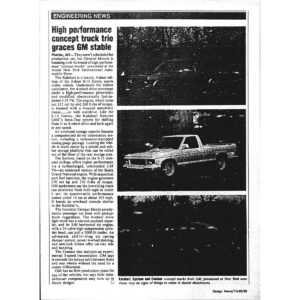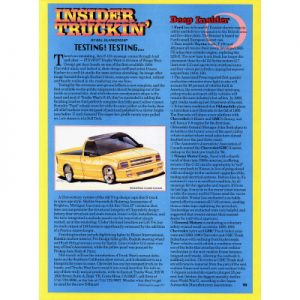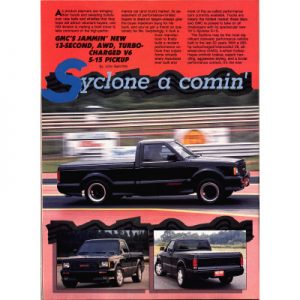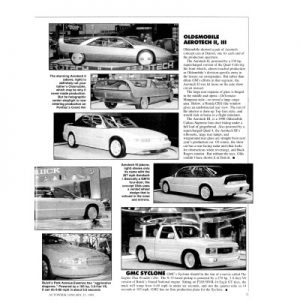Car and Driver
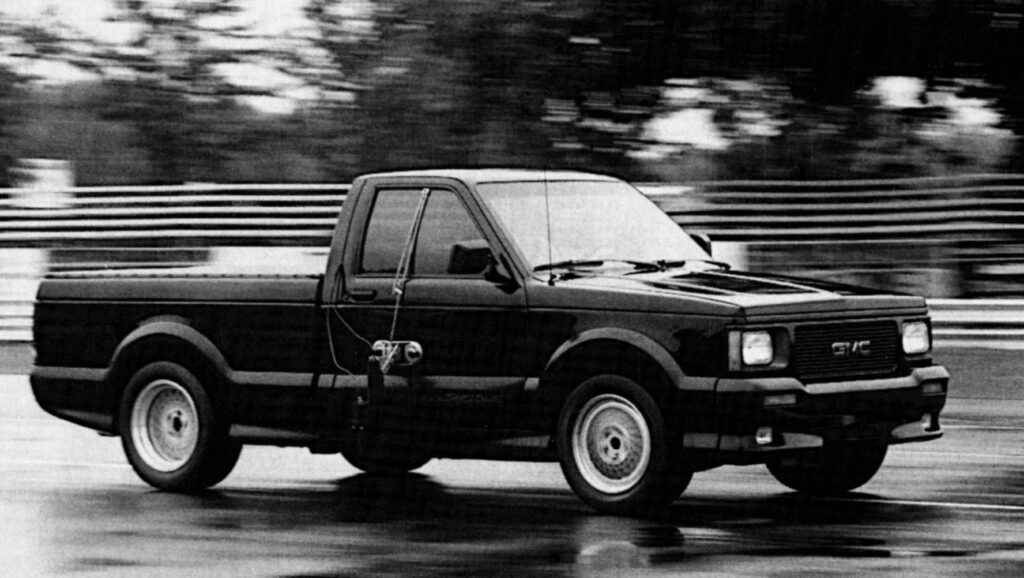
BY NICHOLAS BISSOON-DATH
Step into fantasyland for a moment. Imagine a machine that can accelerate from 0 to 30 mph quicker than a Porsche 959. Imagine it blowing the fat fenders off a Corvette ZR-1 in the sprint to 60 mph. Imagine it running the quarter-mile in 13.0 seconds at 103 mph. Imagine it with full-time four-wheel drive and standard anti-lock brakes. And, just to make things really interesting, imagine that it looks like a pickup truck.
Stop imagining. And feast your eyes on the 1991 GMC Truck Syclone: the baddest, meanest, most outrageous creation to roar out of Detroit since the Buick GNX.
The Syclone is a take-no-prisoners showpiece, a machine created to bolster the GMC Truck Division’s image as a maker of exciting, high-quality vehicles. It springs from a joint venture between GMC and PAS, Inc., of Troy, Michigan–the same company that developed the 20th Anniversary Trans Am for Pontiac. PAS had also developed several GM show cars, so it had plenty of experience developing wild machines like the Syclone.
The Syclone is in fact a highly modified GMC S-15 four-wheel-drive short-bed pickup. Power comes from a turbocharged-and-intercooled version of GM’s 4.3-liter V-6. The turbocharger is a water-cooled Mitsubishi RH06 unit integral with a waste gate; it blows through an air-to-water intercooler. New cast pistons reduce the compression ratio to 8.35:1. Different intake and exhaust manifolds accommodate the turbocharger plumbing, a port-fuel-injection system with Bosch injectors, and a large throttle-body from GM’s 5.7-liter L98 V-8. GMC/PAS also adds the oil cooler and heavy-duty radiator from the S-15’s towing package and fits a single exhaust pipe with no muffler. So fortified, the engine produces a whopping 285 hp at 4200 rpm and 360 pound-feet of torque between 2800 and 3600 rpm. The flat torque is achieved by using the engine-management system to keep the boost pressure within the prescribed torque limits of the transmission. EPA fuel-economy projections are 17/24 mpg city/highway.
The engine drives through a Corvette 700R4 four-speed automatic transmission with a recalibrated shift schedule; the center-console-mounted shifter also comes from the Corvette. Power is fed to all four wheels via the same full-time four-wheel-drive system found in the GMC Safari “L-Van.” This system uses a planetary-gear center differential in-unit with a viscous coupling; the torque split is normally 35/65 front/rear. A Borg-Warner chain drive transfers power to a new front driveshaft. The rear driveshaft is from a standard S-15 4×4. The axle shafts are all from the 1992 four-wheel-drive S-15, because they incorporate the necessary hardware to accommodate the Syclone’s Kelsey-Hayes full-time four-wheel anti-lock braking system. A limited-slip rear differential is standard.
Appropriately, the Syclone’s suspension is calibrated for optimum ride and handling rather than high load capacity and ground clearance. The unequal-length-control-arm front suspension and the live-axle rear setup from the standard S-15 are retained, but the ride height has been lowered 1.5 inches, the front anti-roll bar is larger, and the shocks, front torsion bars, and rear leaf springs are softer. The Syclone’s 8.0-by-16-inch wheels are a unique two-piece cast-aluminum design, fitted with specially developed 245/50VR-16 Firestone Firehawk mud-and-snow tires.
Completing the package is a full set of ground-effects styling pieces, including a new front air dam with integrated driving lights. A tonneau cover for the pickup bed is standard. You can have the Syclone in any color you want, as long as it’s black.
Although the exterior is far from subtle, it hardly prepares bystanders for the Syclone’s unbelievable performance. Thanks to its full-time four-wheel-drive system and turbo engine, the Syclone has unbeatable starting-line traction and incredible acceleration. From rest, it reaches 30 mph in just 1.4 seconds–quicker than any other production vehicle we have ever tested. It reaches 40 mph in only 2.2 seconds–as quickly as a Porsche 959. The sprint to 60 mph takes a mere 4.3 seconds, 0.3 second better than a Corvette ZR-1. Keep the hammer down and 100 mph is yours in twelve seconds flat. In fact, the Syclone keeps punishing the pavement until the engine electronics abruptly halt the fun at 120 mph. All this from a pickup truck.
The Syclone’s performance is even more mind-boggling in the rain, where traction is usually severely limited. On a Wet test track, we recorded a 0-to-60 mph time of 4.6 seconds (the same as a ZR-I1 in the dry) and a quarter-mile run of 13.4 seconds at 100 mph. Only the world’s most serious supercars can better those figures–and they all need a dry road to do it.
The Syclone’s performance may be brutal, but it’s so well suited to everyday driving situations that the vehicle is simply invincible in stoplight Grands Prix. The starting-line procedure is simple: hold the revving engine with the brakes until the rear wheels just start to spin, then go for it. You don’t even have to shift. The Syclone does it all with the transmission in the overdrive slot.
The Syclone is equally formidable on the move. Its top-gear acceleration times are astounding: the combined 30-to-50-mph and 50-to-70-mph number of 6.2 seconds ranks at the top of our record books for production cars.
Our limited experience with the Syclone suggests that its prodigious drag-strip ability is complemented by a competent chassis. The standard power steering is reasonably weighted, with feedback building nicely in response to cornering loads. The body stays flat in high-g turns, and the platform maintains its line faithfully regardless of throttle movements. Pushed to its limit, the Syclone understeers moderately.
When it comes to hauling the speed back down again, all-out anti-lock braking will stop the truck in 186 feet from 70 mph. And the brake pedal feels firm and linear in everyday use.
In addition to outstanding performance, Syclone buyers will get the full luxury treatment. Standard equipment includes air conditioning, an AM/FM/cassette system with four speakers, tinted glass, cruise control, a leather-wrapped tilt steering wheel, and power windows and locks. The interior also boasts several modifications engineered by PAS. These include a new center console that houses the Corvette shifter and assorted cubbyholes, new door panels, and recontoured seats with thicker cloth upholstery. New bucket seats, based on the standard GM chairs, provide plenty of comfort and support–despite lacking a backrest-angle adjustment. Gauges from the Pontiac Sunbird Turbo replace the standard instrument cluster. Only one option exists: a manual pop-up sunroof
The bottom line for all this excitement and luxury is an expected base price of $24,900 when the Syclone goes on sale in January. That’s a steal for a vehicle with so much performance–particularly when you consider that an ordinary, similarly equipped S-15 4×4 currently goes for about $19,000. And unlike some limited-production specials, the Syclone’s actual out-the-door price should stay relatively close to the sticker–GMC intends to build 3000 Syclones during the first year and has enough factory capacity for up to 10,000 annually after that. But don’t wait: the platform on which the Syclone is based is scheduled to be replaced in 1993, and who knows what models will be offered then. So if you want one of the wildest, most affordable supertoys in the automotive kingdom–one that’s guaranteed to satisfy come rain or shine–get in line now.
| Vehicle type: front-engine, four-wheel-drive, 2-passenger, |
| 2-door pickup truck |
| Estimated base price: $24,900 |
| Engine type: turbocharged and intercooled V-6, iron block |
| and heads, GM electronic engine-control system |
| with port fuel injection |
| Displacement …………………………………….. 262 cu in, 4300cc |
| Power (SAE net) ………………………….. 285 bhp @ 4200 rpm |
| Transmission ………………….. 4-speed automatic with lockup |
| torque converter |
| Wheelbase ……………………………………………………….. 108.3 in |
| Length ………………………………………………………………. 180.5 in |
| Curb weight ……………………………………………………….. 3526 lb |
| Zero to 60 mph ………………………………………………….. 4.3 sec |
| Zero to 100 mph ………………………………………………. 12.0 sec |
| Standing ¼-mile ……………………………. 13.0 sec @ 103 mph |
| Top speed (manufacturer’s rating) ……………………. 120 mph |
| Braking, 70-0 mph ………………………………………………… 186 ft |
| Projected EPA fuel economy, city driving …………… 17 mpg |
Copyright © Hachette Filipacchi Magazines. All rights reserved.
Reprint rights granted by Hachette Filipacchi New Media on January 20, 2000.

